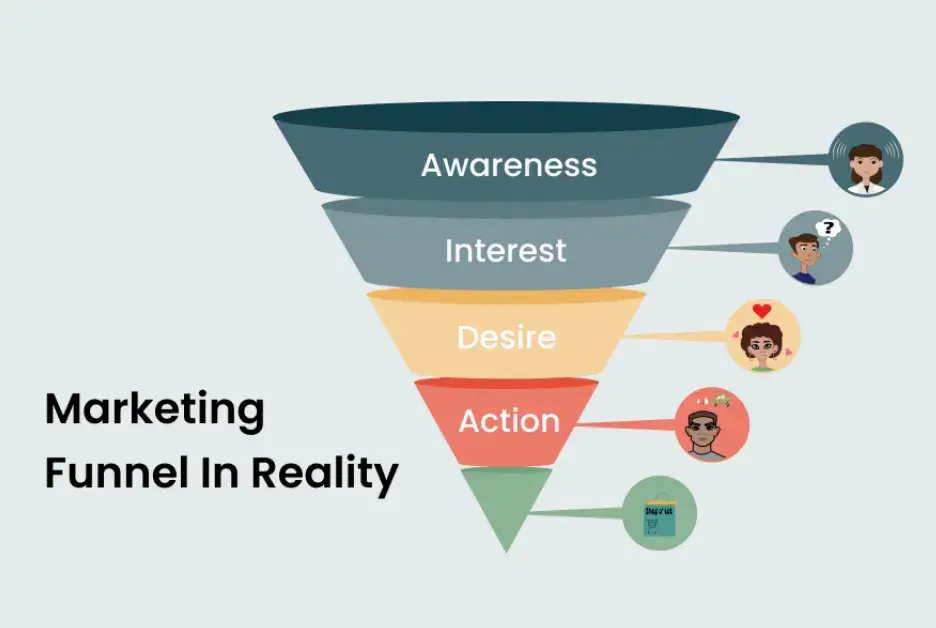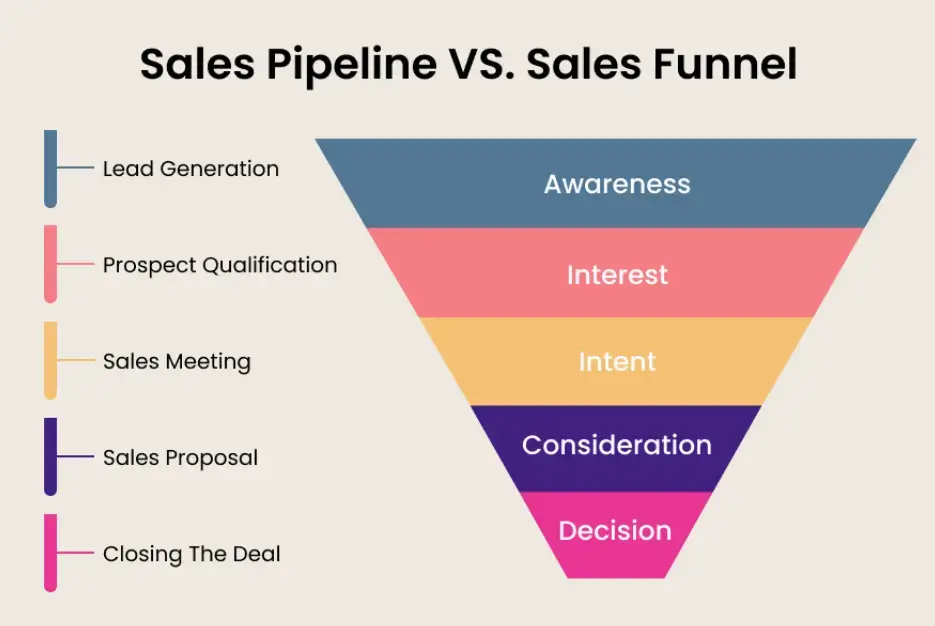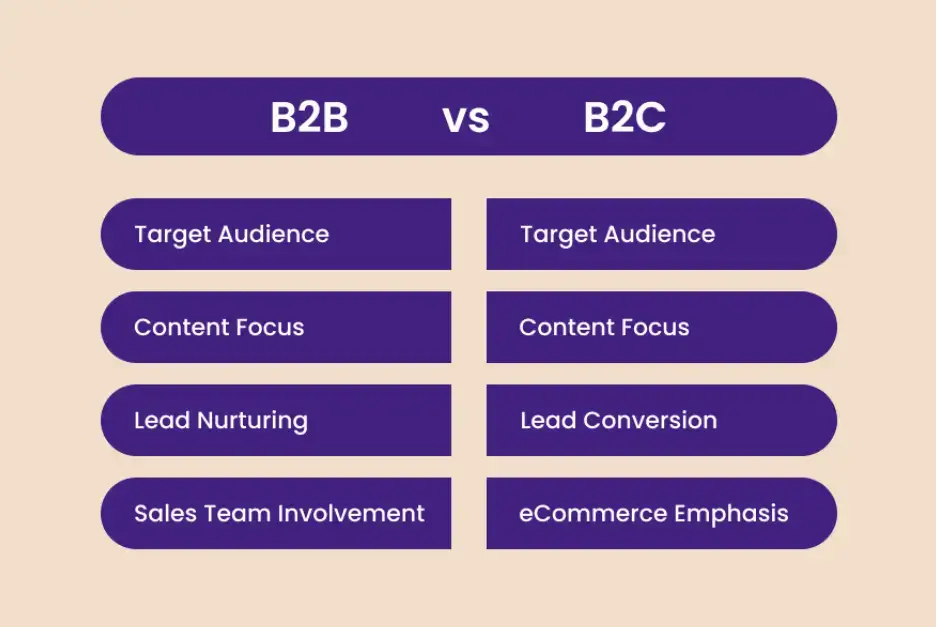Are you struggling to convert leads into loyal customers? You've put your heart and soul into your business, yet somehow your marketing efforts seem to vanish into thin air.
It's frustrating, right? But fear not! We're here to change that game entirely.
Shortcuts:
- 7 Ways to Skyrocket Your Sales
- Marketing Funnel and Sales Funnel Differences
- Difference Between B2B and B2C Marketing Funnels
- 6 Strategies for an Effective Marketing Funnel Strategy
- Marketing Funnel Stages Explained
- Marketing Funnel FAQs
Marketing funnel strategies are like a special trick you can use. They help change people who are interested into happy customers, and your sales graph goes up high, like a tall mountain.
The marketing funnel guides the customer journey from awareness to conversion, with web crawling enhancing lead generation.
What Exactly is a Marketing Funnel?
A marketing funnel also called a purchase funnel is like a helpful roadmap that guides potential customers on their journey to becoming happy customers.
It's a smart tool used by marketing teams to attract, engage, and convert people into loyal buyers using various marketing materials, such as engaging content, eye-catching landing pages, and persuasive ads.
The marketing funnel often follows the “AIDA” model, which stands for Awareness, Interest, Desire, and Action.

In the video below by YouTube influencer Alex Cattoni, she breaks down the concept of the marketing funnel and offers insights on crafting an effective one.
Let me break it down in a more straightforward way:
7 Ways to Skyrocket Your Sales
- Clear customer journey
- Level up your lead generation
- Higher conversion rates
- Better customer engagement
- Data-driven decisions
- Increased customer retention
- Cost efficiency
Marketing funnels offer numerous benefits for businesses seeking to maximize their sales and customer acquisition efforts.
Implementing a well-designed marketing funnel can significantly impact your bottom line and overall business success.

1. Clear customer journey
Marketing funnels provide a clear roadmap of the customer journey from the initial awareness stage to making a purchase.
This clarity allows businesses to understand their customers better and tailor their marketing strategies accordingly.
2. Level up your lead generation
When we sort leads into different stages of the funnel, depending on how close they are to buying, businesses can focus on nurturing prospects and converting them into customers effectively.
3. Higher conversion rates
A well-optimized marketing funnel guides potential customers through the buying process, increasing the likelihood of conversion. It reduces friction and provides the necessary information and incentives for prospects to take action.
This path makes more folks say "yes" and become customers. The best part? It's all made simple, and we give them the details and reasons to make the jump.
4. Better customer engagement
Marketing funnels enable businesses to engage with their audience at various touchpoints, creating meaningful interactions and building stronger relationships.
Engaged customers are more likely to become repeat buyers and brand advocates.
5. Data-driven decisions
Examining how each stage performs in the marketing funnel empowers businesses to collect valuable data and insights.
This helps them make decisions based on data, improve marketing strategies, and allocate resources more efficiently.
6. Increased customer retention
Marketing funnels don't end at the point of purchase; they extend to post-purchase interactions. By maintaining communication with customers after the sale, businesses can foster loyalty and encourage repeat purchases.
7. Cost efficiency
Marketing funnels focus on attracting and nurturing high-quality leads, reducing the wastage of resources on uninterested or unqualified prospects. This results in a more cost-efficient marketing process.
Marketing Funnel and Sales Funnel Differences
While the terms "Marketing Funnel" and "Sales Funnel" are sometimes used interchangeably, they actually depict different phases in the customer journey.
Incorporating effective marketing and sales services can bridge the gap between these funnels, allowing for a seamless transition for potential customers.
When executed correctly, these services can elevate a brand's reach and significantly improve conversion rates.
Grasping this distinction is crucial for effectively coordinating digital marketing and sales efforts:
-
Marketing funnel
The marketing funnel focuses on the initial stages of the customer journey, primarily revolving around creating awareness and interest in a product or service.

4 Key Stages of the Marketing Funnel
- Awareness: This stage involves attracting potential customers' attention and introducing them to your brand or offerings. Marketing efforts at this stage aim to generate interest and curiosity.
- Interest: Once prospects are aware of your brand, the goal is to capture their interest and encourage further exploration. Content marketing, social media engagement, and lead-generation activities play a crucial role in nurturing this interest.
- Consideration: At this stage, prospects are evaluating your offerings against competitors. Marketing efforts focus on providing valuable information and addressing customer pain points to influence their decision-making process positively.
- Intent: In the intent stage, prospects have shown a strong inclination toward making a purchase.
Marketing efforts shift towards convincing and persuading prospects to convert into customers. We'll discuss each stage further later in the article.
Now, let’s break down the stages of the sales funnel which are:
-
Sales funnel
The sales funnel, also known as the conversion funnel, comes into play after the marketing funnel has generated leads.
It focuses on guiding leads through the final stages of the customer journey to make a purchase decision. The key stages of the sales funnel are:

5 Key Stages of the Sales Funnel
- Awareness: The adventure begins with captivating content that ignites interest. From blog gems to tools like calculators to intriguing social media stories, we weave a web of curiosity, building brand presence and trust.
- Interest: As curiosity evolves, we stoke the flames of intrigue. Deep dives into expert insights, webinars that captivate, and stories that resonate. We kindle the flames of interest, transforming casual seekers into eager learners.
- Consideration: At the crossroads of decision, we serve as guides. Offering side-by-side comparisons, immersive experiences, and custom-fit solutions that illuminate the path. Our commitment to personalization ensures your journey is an informed and gratifying one.
- Decision: Decision time calls for seamless simplicity. Our clear calls-to-action beckon action, incentives, and exclusives sweeten the deal, and streamlined pathways make conversion a breeze.
- Action: But the journey doesn't end with conversion. We welcome, support, and celebrate our new allies. Exceptional post-purchase experiences lay the foundation for lasting relationships.
Difference Between B2B and B2C Marketing Funnels
B2B (Business-to-Business) and B2C (Business-to-Consumer) marketing funnels differ in their approach due to the distinct nature of their target audiences.

Understanding these differences is vital for tailoring marketing strategies to the specific needs and preferences of each segment:
|
B2B |
B2C |
|
Lower Volume, Higher Value |
Higher Volume, Competitive Pricing |
|
Focus on Education and Efficiency |
Emphasis on Entertainment and Convenience |
|
Nurturing Interpersonal Relationships |
Transactional Relationships |
|
Driven by Logic and Features |
Appeals to Desires and Benefits |
|
Aimed at Long-term Goals |
Geared Towards Short-term Goals |
|
Typically Involves a Lengthy Sales Cycle |
Characterized by Short Sales Cycles |
"In the world of marketing, understanding the nuances of B2B and B2C marketing funnels is like deciphering the unique dialects of two distinct languages. Success lies in speaking the right language to the right audience." says Tuhin Bhatt, Co-founder - London App Development
-
B2B Marketing Funnel
In B2B marketing, the funnel involves longer sales cycles and more intricate decision-making steps. The distinctions in the B2B marketing funnel are:
- Target audience: B2B marketing focuses on businesses and professionals as the main audience. The decision-making process often includes many people, which means a more thoughtful and tailored approach is needed.
- Content focus: B2B marketing content highlights industry know-how, expertise, and how products or services can be useful. This content is usually more detailed and informative to address the specific needs of businesses.
- Lead nurturing: B2B lead nurturing means creating lasting relationships with potential clients. This is done by offering helpful educational content, personal communication, and addressing their specific challenges.
- Sales team involvement: The B2B sales team is crucial in guiding leads through the funnel. This might involve several interactions, meetings, and proposals tailored to match each prospect's needs.
The B2C marketing funnel typically involves shorter sales cycles and a more emotional approach to decision-making. Key distinctions in the B2C marketing funnel include:
- Target audience: B2C marketing targets individual consumers rather than businesses. The decision-making process is often driven by emotions, desires, and immediate needs.
- Content focus: B2C marketing content tries to bring out emotions, dreams, and wants in consumers. It focuses on storytelling, entertainment, and forming a bond with the brand.
- Lead conversion: B2C lead conversion is often more spontaneous and impulsive. Calls-to-action may focus on limited-time offers, discounts, or other incentives to encourage immediate purchases.
- E-commerce emphasis: B2C marketing often involves a strong emphasis on e-commerce platforms aimed at developing an eCommerce store to facilitate quick and convenient transactions.
Adapting marketing strategies to suit the unique needs of both B2B and B2C audiences is crucial for boosting conversions and forming lasting customer relationships.
6 Strategies for an Effective Marketing Funnel Strategy
- Content Marketing: Educate and entertain
- Social Media Engagement: Connect and build relationships
- Search Engine Optimization (SEO): Be visible
- Email Marketing: Nurture leads
- Retargeting Campaigns: Remind and re-engage
- Personalization: Tailor the experience
A well-crafted marketing funnel strategy is the backbone of successful marketing campaigns. Here are some strategies to enhance your marketing funnel:
1. Content Marketing: Educate and entertain
Content marketing plays a pivotal role in the top-of-the-funnel stage. Create engaging, informative, and shareable content that resonates with your target audience.
Use blog posts, infographics, videos, and social media content to educate and entertain potential customers, leading them to explore your offerings further.
2. Social Media Engagement: Connect and build relationships
Leverage the power of social media platforms to connect with your audience and build lasting relationships.
Engage in conversations, respond to comments, and share user-generated content to foster a sense of community around your brand.
3. Search Engine Optimization (SEO): Be visible
Making your website and content search-engine friendly is important to draw in natural traffic. Find suitable keywords and smoothly blend them into your content to enhance visibility and attract specific visitors to your site.
4. Email Marketing: Nurture leads
Email marketing is a great way to nurture leads in the middle of the funnel. Send prospects content that's valuable and tailored to their interests and actions, helping them move closer to deciding to buy.
5. Retargeting Campaigns: Remind and re-engage
Retargeting or remarketing campaigns help re-engage prospects who showed interest but didn't convert.
Display relevant ads to remind them of your brand, product, or service, encouraging them to return and complete the purchase.
6. Personalization: Tailor the experience
Provide tailored experiences to prospects at every stage of the funnel. Use data and insights to understand their preferences and needs, offering content and suggestions that connect with them.
Marketing Funnel Stages Explained
Mastering the four vital stages of a marketing funnel is essential for boosting your conversion rates and fueling growth:

1. Awareness stage
At the beginning of the funnel, the goal is to make people aware of your brand and draw in potential customers. To make this stage work best:
- Use High-Quality Content: Create valuable, informative, and entertaining content that showcases your expertise and addresses your audience's pain points. By providing high-quality content relevant to your audience, you can keep them returning for more.
- Social Media Presence: Engage with your target audience on various social media platforms to establish a strong online presence and increase brand visibility.
- Influencer Marketing: Collaborate with influencers and industry experts to reach a broader audience and build trust and credibility.
2. Interest stage
In the middle of the funnel, prospects have shown interest in your brand or product. To optimize this stage:
- Lead Magnets: Offer free resources such as e-books, guides, or webinars to capture leads' contact information and continue the nurturing process.
- Email Drip Campaigns: Implement automated email sequences to deliver relevant content and keep prospects engaged with your brand.
- Segmentation: Divide your leads according to their actions, interests, and details to provide content that suits them best.
3. Decision stage
At the bottom of the funnel, prospects are close to purchasing. To optimize this stage:
- Clear Call-to-Action (CTA): Use compelling CTAs that guide prospects to take the desired action, whether purchasing or requesting a consultation.
- Social Proof: Showcase testimonials, reviews, and case studies to build trust and reassure prospects that your product or service delivers its promises.
- Limited-time offers: Create a sense of urgency with time-sensitive offers to encourage prospects to act quickly.
4. Action stage
The action stage is where leads convert into customers. To optimize this stage:
- Streamlined Checkout Process: Ensure a smooth and user-friendly checkout process to minimize cart abandonment and boost conversions.
- Post-Purchase Follow-Up: Send thank-you emails and follow-up messages to show appreciation and encourage repeat business.
- Upselling and Cross-Selling: Offer additional products or services that complement the customer's purchase to increase the average order value.
Marketing Funnel FAQs
1. How long does it take to see results from a marketing funnel?
The time it takes to see results from a marketing funnel can vary depending on various factors, such as your industry, target audience, and the complexity of your offerings.
It's essential to track and analyze your funnel's performance regularly to identify areas for improvement.
2. Can a marketing funnel be applied to different industries?
Yes, the concept of a marketing funnel is applicable to various industries and businesses.
However, the specific strategies and tactics used may differ based on the nature of the products or services offered and the preferences of the target audience.
3. How do I measure the effectiveness of my marketing funnel?
To measure the effectiveness of your marketing funnel, track key performance indicators (KPIs) such as conversion rates, click-through rates, bounce rates, and customer acquisition cost (CAC).
Analyze the data to identify bottlenecks and areas that require optimization for your

